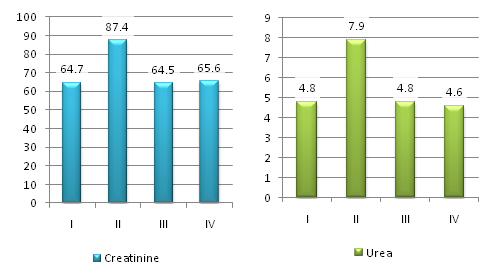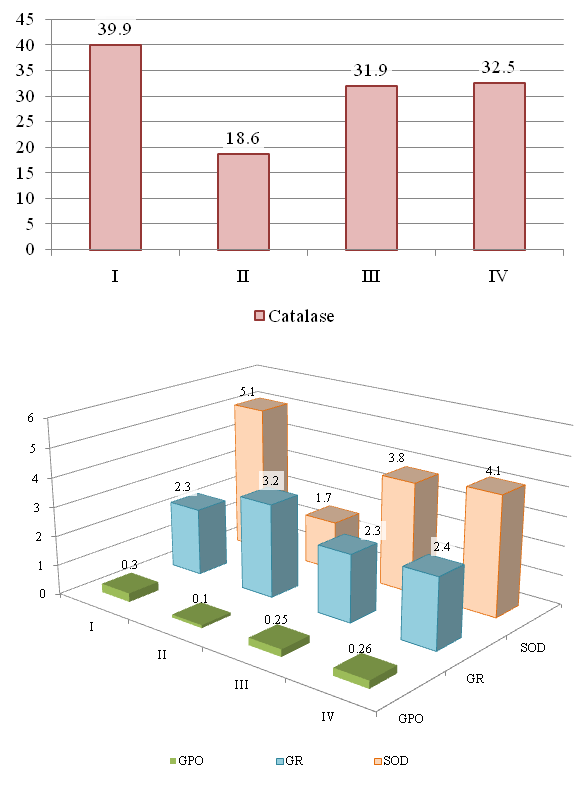-
Paper Information
- Next Paper
- Paper Submission
-
Journal Information
- About This Journal
- Editorial Board
- Current Issue
- Archive
- Author Guidelines
- Contact Us
American Journal of Medicine and Medical Sciences
p-ISSN: 2165-901X e-ISSN: 2165-9036
2023; 13(8): 1129-1133
doi:10.5923/j.ajmms.20231308.20
Received: Jul. 29, 2023; Accepted: Aug. 22, 2023; Published: Aug. 28, 2023

New Infusion Drugs of Antioxidant Action in Burn Injury: Evaluation of the Efficacy
Larisa Shevchenko1, MirzoAnvar Ibragimov2, Timur Alimov3, Khamid Karimov4
1Laboratory of Blood Substitute Infusion Drugs, Republican Specialized Scientific-Practical Center of Hematology of the MoH RUz, Chilonzor distr. Arnasay str. 17, Tashkent, Uzbekistan
2Administration, Fergana Medical Institute of Public Health, Fergana Region, Fergana City, Yangi Turon str. 2, Uzbekistan
3Vivarium, Republican Specialized Scientific-Practical Center of Hematology of the MoH RUz, Tashkent, Uzbekistan
4Department of Molecular Medicine and Cell Technologies, Republican Specialized Scientific-Practical Center of Hematology of the MoH RUz, Tashkent, Uzbekistan
Correspondence to: Larisa Shevchenko, Laboratory of Blood Substitute Infusion Drugs, Republican Specialized Scientific-Practical Center of Hematology of the MoH RUz, Chilonzor distr. Arnasay str. 17, Tashkent, Uzbekistan.
| Email: |  |
Copyright © 2023 The Author(s). Published by Scientific & Academic Publishing.
This work is licensed under the Creative Commons Attribution International License (CC BY).
http://creativecommons.org/licenses/by/4.0/

Purpose of the study. To study the efficacy of blood substituting infusion drugs Reomannisol and Rheoambrasol on the model of burn shock. The experiments were carried out on 60 male rats weighing 180-200g on the model of burn shock. The results of the study allowed to establish the correction of biochemical parameters in burn shock by new blood substituting infusion drugs: Reomannisol and Rheoambrasol. The use of Reomannisol and Rheoambrasol in experimental animals in burn shock led to a decrease in the intensity of lipoperoxidation processes (LPO), restoration of the activity of antioxidant system enzymes (AOS). The results of these studies give grounds to recommend antioxidant infusion medicinal preparations Reomannisol and Rheoambrasol in thermal injuries.
Keywords: Burn, Shock, Antioxidant, Blood substituting infusion drugs, Experiment
Cite this paper: Larisa Shevchenko, MirzoAnvar Ibragimov, Timur Alimov, Khamid Karimov, New Infusion Drugs of Antioxidant Action in Burn Injury: Evaluation of the Efficacy, American Journal of Medicine and Medical Sciences, Vol. 13 No. 8, 2023, pp. 1129-1133. doi: 10.5923/j.ajmms.20231308.20.
Article Outline
1. Introduction
- It is known that burn injury naturally leads to generalized metabolic disorders, energy exchange disorders, excessive accumulation of lipoperoxidation and insufficient antioxidant protection. The pathogenesis of deep disorders of cellular metabolism in burn injury is based on hypoxia, which develops due to disturbance of oxygen homeostasis [6].In this regard, the use of antioxidants in the therapy of thermal trauma, which determines the outcome and timing of treatment, is extremely relevant. Antioxidants capable of increasing the energy potential of cells and restoring their metabolism under hypoxia are of the greatest interest for the therapy of burn disease [6].Such means include blood substitutes developed in our laboratory (Blood Substitute Infusion drugs Laboratories, Republican Specialized Scientific and Practical Medical Center of Hematology of MoH RUz) "Reomannisol" and "Rheoambrasol" [5,12].
2. Main Body
2.1. Purpose of the Study
- Purpose of the study. To study the efficacy of infusion drugs "Reomannisol" and "Rheoambrasol" on the model of burn shock.
2.2. Material and Methods of Investigation
- The experiments were carried out on 60 male rats weighing 180-200g. The model of burn shock was reproduced by applying a copper plate with dimensions 3x3 cm heated to 200°C in the area of the rat's back, under ether anesthesia [4,9].The experiments were conducted in accordance with the requirements of humane treatment of animals.Animals were divided into 4 groups: Group I - intact, Group II - control (burn without treatment), Group III - burn shock after “Reomannisol” infusion. Group IV - burn shock after Rheoambrasol administration.Blood substituting infusion drugs ("Reomannisol" (III – group) and "Rheoambrasol" (IV-group)) were administered at a dose of 40 ml/kg body weight of the animal between 2 h and 2 h 30 min after the burn.In the III - group, for 5 days, infusion to rats of the drug "Reomannisol": 2 hours after the shock and in the following days - 40 ml / kg of body weight of the animal.In group IV, rats were infused with Rheoambrasol for 5 days: 2 hours after the simulation of burn shock – 40 ml/kg of animal body weight was injected, and on subsequent days – 10 ml/kg of animal body weight.Biochemical indicators of blood and indicators of acid-base state (arterial blood pH) and blood electrolytes (concentration of potassium and sodium ions), were recorded in animals [7].Biochemical studies: alanine aminotransferase (ALT), aspartate aminotransferase (AST), glucose, urea, creatinine, sodium, potassium, total protein were performed using appropriate test kits HUMAN (Germany). Measurements were performed on BA88 analyzer (Myndray, China). Blood pH was determined on the device "Radelkis OP-215". Electrolyte composition of blood - the content of sodium and potassium ions concentration was determined on a biochemical semi-automatic analyzer Mindray BA88 using test systems "Human".The content of lipid peroxidation products (MDA, diene ketones (Dket), diene conjugates (Dcon)) was determined according to the method of G.R. Titeeva and N.N. Korovina, using the TBK-AGAT kit ("Agat-Med", Russia). The products were calculated using the molar extinction coefficient and expressed in nmol/mg. Diene conjugates and diene ketones were determined in hexane extracts of blood serum (1996) [1]. The activity of catalase (CAT) in blood was determined according to the method of M.A. Korolyuk et al. (1998) [8], the principle of which is based on the ability of H2O2 to form a stable colored complex with molybdenum salts. The measurements were carried out at a wavelength of 410 nm. The enzyme unit (U) was taken as the amount of enzyme required to convert 1 μmol of substrate in 1 min at 25°C.The activity of superoxide dismutase (SOD) was determined according to the method of V.G. Mkhitryan et al. (1978) [10]. The activity was calculated by the percentage of inhibition (T%) of tetrazolium blue reduction in alkaline medium. The amount of enzyme required for 50% inhibition of nitroblue tetrazolium reduction in the non-enzymatic system of phenazine methasulfate and NADH was taken as the unit of SOD activity (U). Enzyme activity was expressed in units/min x mg protein. Superoxide dismutase (SOD) activity in erythrocytes was expressed in units/min x mg Hb [2]. The purified preparation of SOD (ICN Biomedicals, USA) was used as a standard [13].The activity of glutathione peroxidase (GPO) was determined by the accumulation of oxidized glutathione (GSSG) as a result of lipoperoxide degradation. Enzyme activity was expressed in units/min x mg Hb per min. The activity of erythrocyte glutathione reductase was determined in the reaction medium of phosphate buffer at a wavelength of 340 nm and by the decrease of NADPH*H and expressed in μM NADPH2/min x g Hb (Vlasova S.N. et al., 1990) [3].Determination of the content of POL products in the blood of experimental animals was carried out using the TBK-AGAT kit (Russia) according to the method of G.R. Titeeva and N.N. Korovina [11]. The result was expressed in nmol/mg. Diene conjugates (Dcon) and diene ketones (Dket) were determined in hexane extracts of blood serum (1996).Measurements were performed on a UNICO2800 spectrophotometer (USA).Statistical processing of the study results was performed using “Excel” and “Primer of biostatistics V 4.03” (Biostatistics for Windows) applications. P-criterion value less than or equal to 0.05 (p≤0.05) was accepted as a criterion of statistically reliable (significant) differences in the value of the studied parameters.
2.3. Results and Discussion
- Based on experimental data, the blood substitute Reomannisol (containing in its composition 2 antioxidants succinic acid and mannitol) developed in our laboratory had an effective effect on biochemical parameters in burn shock.As shown in Figure 1, in rats in burn shock, ALT concentration increased 1.5-fold (p≤0.05), AST concentration increased 1.3-fold (p≤0.05), creatinine concentration increased 1.4-fold (p≤0.05), urea concentration increased 1.6-fold (p≤0.05) (Figure 4) and total protein level decreased 1.4-fold (p<0.001). The electrolyte composition of serum changed as follows: sodium concentration decreased by 2.8% (p≤0.05) and potassium concentration increased by 16.2% (p≤0.05) (Figure 2). Blood pH decreased to 7.33±0.01 units, which was 0.09 units less compared to baseline data (Figure 3).
 | Figure 1. ALT and AST in burn shock and after infusion of blood substitutes in rats |
 | Figure 2. Sodium and Potassium in burn shock and after infusion of blood substitutes in rats |
 | Figure 3. pH in burn shock and after infusion of blood substitutes in rats |
 | Figure 4. Changes in the concentration of urea and creatinine in burn shock and after infusion of blood substitutes in rats |
 | Figure 5. Changes in the concentration of LPO-indicators in burn shock and after infusion of blood substitutes in rats |
 | Figure 6. Changes in the concentration of AOS-indicators in burn shock and after infusion of blood substitutes in rats |
4. Discussion of Results
- There is a change in biochemical indicators: increase in ALT and AST, a significant increase in the concentration of urea and creatinine in the blood, which indicates a violation of liver and kidney function in burn injury. On the background of thermal trauma there is activation of POL processes and on the background of depletion of antioxidant system, which leads to the formation of oxidative stress.In burn shock there is activation of lipoperoxidation processes (LPO) and against the background of antioxidant system depletion, which leads to the formation of oxidative stress. In such conditions introduction of new blood substitutes “Reomannisol” and “Rheoambrasol” stabilizes the processes of LPO of biomembranes and restores the level of peroxidation products and the activity of antioxidant system enzymes. this is primarily due to the fact that both drugs contain succinic acid, which is able to restore the respiratory chain of mitochondria and restore antioxidant activity.Succinic acid at limitation of NADN – dependent oxidation pathway provides activity and ability to oxidative phosphorylation in the second and third conjugation sites, which contributes to the maintenance of a higher level of macroerg and increases the degree of cell energization. The blood substitute "Reomannisol" contains another antioxidant - mannitol, which when used together with succinic acid enhances antioxidant properties of Reomannisol.The composition of the drug "Rheoambrasol" contains polysaccharide of plant origin, which facilitates the penetration of succinic acid into the cell and its subsequent oxidation in the respiratory chain, which enhances the antioxidant properties of the infusion drug "Rheoambrasol".Biologically active composition including polysaccharide and bioenergetic substrate has a good antihypoxic, antioxidant, detoxification, membrane-protective effect. Thus, the active components of the preparation "Reomannisol" and "Rheoambrasol" have mutually potentiating effects, determine their antioxidant activity in thermal injuries.
5. Conclusions
- The possibility of correction of biochemical parameters in burn shock by new blood substituting infusion preparations "Reomannisol" and "Rheoambrasol" has been established.Infusion of "Reomannisol" and "Rheoambrasol" preparations in experimental animals in burn shock reduces the intensity of LPO processes, restores the activity of antioxidant system enzymes.The results of the study give grounds to recommend antioxidant infusion blood substituting drugs "Reomannisol" and "Rheoambrasol" in thermal injuries.
 Abstract
Abstract Reference
Reference Full-Text PDF
Full-Text PDF Full-text HTML
Full-text HTML